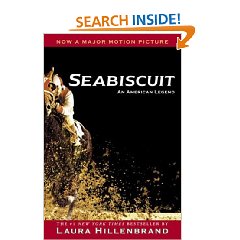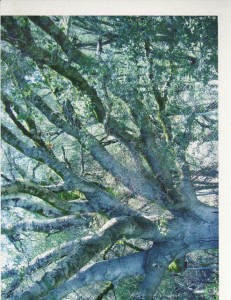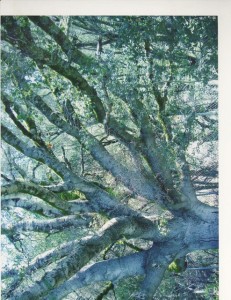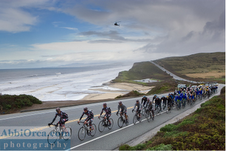|
Hi June,
Here’s a fun story about fishing at Purisima. I don’t have the text part yet, but thought you’d enjoy this. John
|
Michael Powers: Extravaganza on the Water: High Noon, April 19
1930s (Depression Era) Buick Car Dealer Buys Horse…but what a Horse!
Old-New Story by June Morrall
“I wouldn’t give 850 for the best horse living,” said Charles Stewart Howard in 1907.
Years later the pioneer distributor of Buick motorcars might have laughed at his comment.
In the 1930s the distributor-turned-auto-magnate paid many thousands of dollars for the finest thoroughbreds, including the legendary, beloved Seabiscuit, a top-money-winning racehorse that brought cheering fans to their feet when they thundered toward the finish line at Bay Meadows Racetrack in San Mateo.
There was no rise and fall to Charles S. Howard’s rags-to-riches story. His career soared from one high level to the next.
Born in Marietta, Georgia, C.S. Howard enlisted in the army, fought in the Spanish-American war and looked to the West Coast to seek his fortune. He often regaled any and all listeners with the saga of his humble origins, and how he arrived in San Francisco with only two dimes and a penny in his pocket.
Howard was an uncommonly ambitious fellow who opened a bicycle repair shop on Van Ness Avenue. All day long he hardly noticed the parade of horse-drawn carriages passing his storefront, but the occasional gasoline buggy made him drop his tools to admire the man-made machine.
The horse and motorcar were bitter, natural enemies, thought Howard. He predicted motorcars would replace the horse as the popular mode of transportation. The automobile was here to stay, and C.S. Howard set out to be part of that revolutionary future.
Detroit, Michigan was the place to study motorcars, and Howard was drawn to learn his craft. At the Buick Motor Car Company, he established valuable contacts that would pay rich dividends later. He befriended William C. Durant, former horse-drawn carriage manufacturer and founder of General Motors in 1908, an impressive connection.
Although he may not have realized it, Howard was in the right place at the right time.
When C.S. Howard returned to San Francisco after the 1906 earthquake and fire, he was the Buck distributor for eight Western states, with an inventory of two four-cylinder Buicks. He placed his precious vehicles in a stockroom but lost everything in a devastating fire. Undeterred, the optimistic Howard used the insurance money to start over just in time to sell Buick’s sleek White Streak, a hot selling roadster favored by doctors and salesmen.
His Buick motorcars were winning the war against the horse. Despite primitive roads, the m man-made vehicle could carry the driver and his family on scenic trips to the Peninsula, through the giant redwoods, one of the gateways to the Coastside.
But the horse was “king” and didn’t sink into oblivion easily. It still dominated the city’s dusty, pockmarked streets. The public was suspicious of the noisy gasoline buggy that was banned as a nuisance from Golden Gate Park. Yosemite and the Stanford University campus. Worse, popular opinion held that motorcars were a novelty, a fad that would quickly pass.
It was going to be a challenge to change people’s habits, an uphill public relations battle. Bursting with ambition and vision, C.S. Howard was prepared for the fray, reasoning that the path to success was to modify the image of the motorcar.
A talented intuitive fellow, he launched a campaign to focus positive attention on motorcars. Smiling and confident, C.S. Howard was photographed behind the wheel of his own stock models.
He chaired “runs and tours” committees. He demonstrated the reliability of motorcars by entering endurance contests, including “dusty hill climbs, road races and speed tests” held at the Tanforan Race Track in San Bruno—ironically, the home of the “sport of Kings.”
Not all of his publicity stunts were successful. A tire-changing contest failed when only a handful of contestants signed up for the unpleasant task.
But this was a minor setback. It was becoming clear — even to his critics — that C.S. Howard had succeeded in elevating the motorcar from its lowly status as a novelty.
Then he conceived his most brilliant idea yet, a plan that would dramatically increase the sales of cars. Until 1910 C.S. Howard’s inventory consisted of a few vehicles. Potential buyers were not able to make a selection and drive away in the motorcar of their choice. This drove Howard crazy. He was losing sales. If the potential buyer could browse through a substantial inventory of Buicks, sales would soar.
And he was right.
Although it had never been done before, why not ask Detroit to ship him 124 new Buicks by train? Howard’s idea was compelling and Detroit loved it. They shipped a trainload of Buicks, and many called this a first in automobile history.
One year later, 224 Buicks arrived and a second train followed with 228. When a train carrying 375 cars arrived, all previous records were broken. By 1913 the Howard Automobile Company was shipping cars all over California.
C.S. Howard had earned his success. He, along with his wife, Fannie May, and sons, Charles, Jr. and Lindsay, moved to exclusive San Mateo Park. The boys were raised to follow in their father’s footsteps and they, too, went into the car business. In 1927 hundreds of Peninsula residents gathered at Burlingame;s “Auto Row”to celebrate the Grand Opening of Howard Buick, a sparkling new showroom operated by the young brothers.
It didn’t hurt business that their father was known as ‘the world’s greatest automobile distributor.”
Along the way C.S. Howard had made another fortuitous investment, one that would bring him tremendous wealth. He had purchased shares of General Motors stock before WW I at a low price, and it was presumed that he sold them before the shares plummeted from their highs during the great crash of 1929. If these reports were accurate, Howard made a killing on the trades.
As a respected, charitable member of the Peninsula community, he established the Howard Foundation, granting $150,000 for a sanatorium in Belmont for poor children stricken with tuberculosis and rheumatic fever. Burlingame resident Dr. Max Rothschild, an internationally known tuberculosis expert, was appointed as medical director of the small institution.
By 1930 Howard had relinquished part of his sales empire, retaining only his outlet in the automobile-loving state of California — and his marriage was on the rocks.
Litigation kept his name in the public eye as his bitter divorce from Fannie May ended a 30=year marriage. She subsequently married her attorney, Edmond E. Herrscher, and in 1932 C.S.Howard married C.S. Zabala, a member of a distinguished California family.
Howard now embarked on the “celebrity” chapter of his life, indulging himself in the hobbies and pastimes of the super-rich, taking up yachting, hunting big game and breeding thoroughbred racehorses at Ridgewood, his 35,000-acre ranch at Willits in Mendocino County.
He purchased the palatial yacht, Aras, equipped with a luxurious main saloon, dining room, veranda, cafe and gymnasium. For its maiden voyage, Howard invited friends and scientists on an adventurous cruise to the Galapagos Islands off the coast of Ecuador.
Eight thousand miles later, Howard returned to San Francisco with a rare collection of birds and reptiles, including a very tame tropical seabird called “the blue-footed booby.” In addition, there were flamingoes, penguins and iguanas, all of which he donated to the California Academy of Sciences in Golden Gate Park.
A few years later he traveled to Africa on a five month safari, bagging a black maned lion and a fifteen foot python on the same day.
But the automobile magnate won his most enduring fame as the owner of “Seabiscuit,” the great champion thoroughbred who smashed all existing records and won the hearts of the people.
In the 1930s Howard purchased the “undersized, crooked legged racehorse for about 88,000 from co-owner Ogden Mills, grandson of D.O. Mills, the Peninsula’s famous banker (Millbrae is named for him where he built his mansion.)
“Seabiscuit” was a horse that nobody believed could win. The experts sniffed when when they looked at this “runt of a colt.” Both Howard and his trainer, Tom Smith, dissented and smelled a big winner in Seabiscuit. They were right, but had no idea this animal was destined for immortality.
“In the latter half of the Depression, Seabiscuit was nothing short of a cultural icon in America, enjoying adulation so intense and broad-based it transcended sport,” wrote Laura Hillenbrand in her book, “Seabiscuit: An American Legend,”
which also became a highly rated motion picture.
The famous racehorse received more media coverage than FDR or Hitler, notes the acclaimed author.
Seabiscuit’s “appearances smashed attendance records at nearly every major track,” wrote Hillenbrand, and drew two of the three largest throngs ever to see a horse race in the U.S.” The horse that nobody wanted became so popular that crowds came just to watch his workouts.
When Seabiscuit was put out to pasture at Howard’s Ridgewood ranch, he lived the life of an equine celebrity, visited by thousands of fans. Some of the “little Biscuits” he sired became champions in their own right.
Seabiscuit and his owner aged gracefully. When the famous horse died in 1947, Howard buried him at the Willits ranch, planting an oak sapling over his hidden grave.
Three years later the dynamic Charles Stewart Howard passed away at his Hillsborough home, leaving an estimated fortune of 840 million.
C.W.Howard contributed to Californian’s worldwide reputation as “the greatest consumers of automobiles on the globe.” He introduced the motorcar to the American West but he will mostly be remembered as the owner of the great thoroughbred, Seabiscuit.
——-
A New-old story by June Morrall
more coming
1935 (Depression Era): Mondays with the Supes; Tuesdays with the Coastside Civic Union
[Below: I’m trying to make sense out of a politically charged tiff, in 1935, between some county supervisors, including Supervisor Witt, and the editor/publisher of the Half Moon Bay Review.
There’s been a meeting at the Half Moon Bay Inn. Speeding up mail delivery, farm modernization and the revival of the Ocean Shore Railroad has been discussed. I have also included an article about the Coastside Civic Union’s meeting which took place at the same time.
From the Half Moon Bay Review, October 17, 1935
Coastside Civic Union Meets at Half Moon Bay
The Coastside Civic Union held its regular monthly dinner meeting at the Half Moon Bay Inn, Tuesday night, with president M.J. Bettencourt presiding.
The matter of improving the Coastside Mail service was taken up. The postmasters present: W.R. Bailey of Rockaway Beach, R. Guy Smith of Moss Beach, Mrs. Charlotte Cavalli of Half Moon Bay and R.F.D. Carrier Harry L. Nelson of Half Moon Bay spoke on the benefits of an earlier mail arrival. The organization asked Secretary R. Guy Smith to take the matter up with the Post Office Department and find out what could be done in reference to it.
After Major Chas. Gans, county health director, told of the huge population in the north end of the county and its population being 35,000, he said that the hog owners were certainly remodeling their ranches to conform with all the state and county laws and if one were to visit that district now he would see much activity.
Dr. Gans then introduced Sid F. Dommes, Jr., district supervisor of community sanitation, U.S. Department of Health, who spoke at length about sanitation for the rural districts and asked for cooperation stating that the county health department was assisting in the campaign being waged under the WPA for modernizing farm sanitation. The farmers are now required to supply about $24 and the federal government will supply the work for building privies.
—————-
October 17, 1935
From the Half Moon Bay Review
Dunn Answers
Blast From Witt,
Kellogg at Meet
After being introduced by President M.J. Bettencourt at the monthly meeting of the Coastside Civic Union Monday night, Supervisor Al Witt and County Executive Walter Kellogg condemned the press of San Mateo county in general and the Half Moon Bay Review in particular for not publishing a correct interpretation of the meetings at the board of supervisors. Both stated that the activities of the board did not warrant the headlines in the public press.
Answering these accusations, Editor George E. Dunn stated that the press of San Mateo county and particularly the Half Moon Bay Review and Pescadero Pebble were not given to making misstatements, and if anyone present wished to find out the facts all they need do is to attend the meetings of the board of supervisors and they would readily be convinced at the correctness of the press’s statements. Moreover, the papers did by far not publish the complete acts and facts happening at these meetings and that quite a number of these unsavory circumstances deserved much larger headlines. Both of them dealt at length on the so-called efficiency inefficiency of County Engineer Carl R. Scott.
In his talk, the county executive said, “This is my first public statement on why I selected Urban S. Marshall as county engineer to replace James S. James and Carl Scott, I, as executive of San Mateo county, went out of the county for Mr. Marshall because I believe it to be to the best interest of the county, to get an outside engineer, as all engineers were working for or had been working either for James or George Kneese.”
Chairman Francis of the San Mateo county board of supervisors pledged the directors of the Joint Highway District No. 9 support to the Ocean Shore Railroad officials where and when possible and added that the Joint Highway district had turned over $125,000 to the state highway department for the building of the Pedro sector on the boulevard , it was now up to the state for actual construction of that much needed section of the road.
Others who spoke were Mrs. Elsie McGinn, Mrs. Stein, president of the San Mateo Women’s club, Mayor C.A. Buck of Burlingame, Supervisor Walter High, Marshall, Dr. C.C. Gans and others of the county political officialdom.
At the conclusion of the meeting everyone present expressed praise for the notable success of the flower and agricultural fiesta just closed and expressed the wish that it would be a yearly occurrence with ever-growing success.
———————
From an unidentified “newspaper” that brags: Largest Number Coast Readers than all the county Newspapers Combined
Friday, October 19, 1935
Let’s Tell The Truth
Just why a real pleasurable, enthusiastic meeting such as was held by the Coastside Civic Union at the Half Moon Bay Inn on Tuesday evening last, the aftermath of which should be vilified, is what the 100 or more persons who attended are asking each other. As all know, there is no valid reason for the printing of such stories as have been printed in the several newspapers since the meeting, except to give one man some cheap notoriety, practically all which stories are untrue.
Both County Executive Kellogg and Supervisor Al Witt used practically the same expression in speaking of the newspapers of the county: “That the county newspapers did not seem to understand and many times misconstrued the actions of the county board and county officials….”
—–
[Looks like this may be from a political newsletter. There’s no identification.]
Supervisors Aver Stories
Do Injustice
But Dunn, Publisher, Says Press Often Spares Board
That the press stories printed about the supervisors’ meetings every Monday were “incorrect” and “unfair” was charged at a meeting of the Coastside Civic Union last night by Supervisor Albert Witt, Jr., Colma, and County Executive Walter Kellogg.
But George Dunn, Half Moon Bay publisher, who attended the meeting, arose to the defense of the press and asserted that more than often the stories were written to lessen the controversies which actually took place and were not exaggerated, he said.
[Supervisors] Witt and Kellogg next turned their guns of attack on County Engineer Carl Scott and charged that he assertedly was “inefficient.”
Kellogg told the gathering that his purpose in securing the services of Urban S. Marshall, former Piedmonter, now residing here, was to get an outsider who had not had contacts with either former County Engineers George Kneese or James S. James.
Assurance was given the Coastsiders that Harry Cole and associates intend to proceed with the rehabilitation of the Ocean Shore railroad.
Manuel Francis, coast representative, told the gathering that the Ocean Shore highway district recently had turned $125,000 over to the state for work on the coast road.
————–
[This is from an unidentified sheet of paper]
One month ago at the meeting of the Civic Union, I said, among other things, that the people were often given incorrect impressions by our local newspapers at what the Board of Supervisors did at their meetings–that unfavorable headlines which were not justified by the facts, often gave this county unfavorable publicity.
You all who were present heard Mr. Dunn’s feeble defense–scarcely a dozen words–which I now recall your Secretary has quoted quite correctly in his minutes just read.
Next day Bay Dailies carried screaming headlines “Dunn delivers STINGING REBUKE to Witt,” then followed half columns purporting to quote what Dunn had said – In Dunn’s own paper he makes himself use some one hundred words to again mis-inform his readers – he stands convicted of exactly what I accused him of – misstatements in his paper.
If Mr. Dunn cannot correctly quote himself, it’s no wonder he misquotes others.
WHAT DUNN SAID:
“MY NAME HAS BEEN MENTIONED TWICE* THE HALF MOON BAY REVIEW DON’T MIS-REPRESENT – ANYBODY WHO ATTENDS THE BOARD OF SUPERVISORS KNOWS WE DON’T PRINT EVERYTHING.”
—————————–
1925: Come to the Whist Party and Dance
1925: Whist Partty and Dance
Given By
The Pioneer Club At
Montara School House
Music by “The Californians”
Admission 75 cents per Person, including Supper….Valuable Prizes
1935: Return of the Ocean Shore RR???
From an unidentified source, possibly a newspaper, 1935
Many Officials Present
Much Enthusiasm Shown
————–
The Coastside Civic Union held their regular monthly dinner meeting at the Half Moon Bay Inn on Tuesday evening with an unusually large attendance.
All routine work of opening the meeting was passed upon when President M.J. Bettencourt began introducing the county officials and guests. A. P. Black, attorney for the Ocean Shore Railway, told his listeners that the Railroad was prepared and was working upon the construction of the road bed, and all they ask is to be let alone, and inside of another year they would have the pleasure of riding upon a complete railroad.
1930s: Supervisors Hear Coastsiders During Depression Era
From The Times and Daily News Leader, October 1935
Mrs. Margaret T. Kyne , Moss Beach, requested that the County Roads leading from Balboa Boulevard to the terminus of Reliance Avenue in Marine View Addition Tract, be repaired. On motion of Supervisors Witt and Beer, the Engineering Department was instructed to inspect the roads referred to.
——-
The Recreation Committee recommended: (1) That the National Park Service be requested to take jurisdiction over the work program of the SERA camp in Memorial Park in order to continue the work of this camp. (2) That the Planning Commission be requested to designate a representative to assist in coordinating functions of the Planners and the activities of the National Park Service in planning the work program under the foregoing proposal, and (3) that an auxiliary or additional work project under the National Park Service, be provided for development of Thornton Beach, now being acquired by the County.
Secretary Sophie W. Root of the Recreation Commission explained usefulness of the project.
On motion of Supervisors Witt and High, the Commissions recommendations were approved and the Executive authorized to carry out its requests.
————–
Final report of Harry W. Arnold, Lobitos Creek Bridge Inspector, together with a statement signed by Arnold and entitled “Review of the wooden bridges constructed during this period—1934=35.”
——————-
Eva Montevaldo, San Gregorio, complained of the condition of the road leading to her place. On motion of Supervisors High and Beer, the matter was referred to the Engineering Department.
——————-
A petition of 28 property owners and taxpayers of the Half Moon Bay Sanitary District requesting action necessary to eliminate unsanitary conditions in connection with the septic tank at the end of the sewer system in said district, was read. On motion of Supervisors Witt and High, the matter was referred to the Health Director and Engineer for Action.
Does it feel like “The Day the Earth Stood Still?”




My partner, Burt, says only science fiction can describe the horrific situation that is touching all of us. Nobody has experienced what we are going through now. It is an entirely new experience.
Burt says the sci fi flick that most closely parallels what’s happening now is “The Day the Earth Stood Still,” originally released post WWII in 1951. [There was a remake in 2008.]
But, Burt quickly adds, in “The Day the Earth Stood Still,” somebody was in control. There was the ubiquitous “they.” He does not see the they
In the present The Day the Earth Stood Still playing out
Leon Kunke’s Crystal Springs
Image by Leon Kunke



